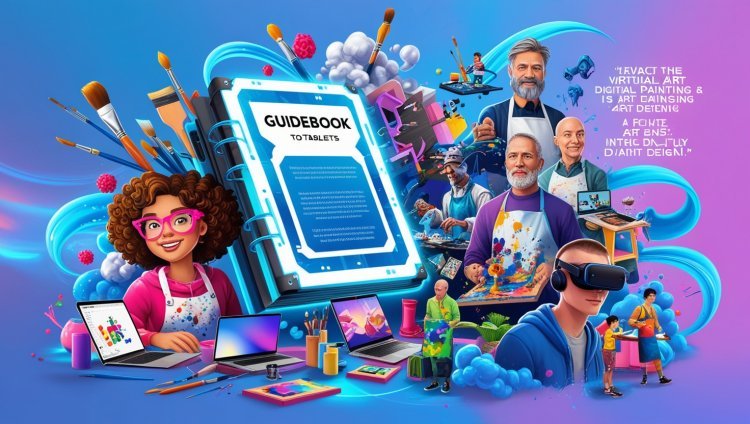A Guide to Exploring Art in the Digital Age
Discover how technology reshapes art exploration today! Learn about online galleries, AI tools & community engagement for artists.

In the digital age, exploring art has transformed dramatically, opening up new avenues for artists and audiences alike. The intersection of technology and creativity has birthed a vibrant ecosystem where traditional boundaries dissolve, allowing art to flourish in innovative ways. This guide delves into the various dimensions of exploring art in the digital age, highlighting platforms, trends, and opportunities that redefine how we engage with artistic expression.
The Digital Revolution in Art
The digital revolution has fundamentally altered the way art is created, shared, and experienced. Artists are no longer confined to physical galleries; they can now showcase their work on various online platforms that reach global audiences. This shift democratizes access to art, enabling emerging artists to gain visibility and connect with collectors without the barriers posed by traditional galleries.
Online Art Galleries: A New Frontier
Online art galleries have become pivotal in this transformation. Platforms such as larimartgallery provide artists with the tools to present their work professionally while allowing collectors to discover unique pieces from around the world. These galleries often feature a diverse range of artworks, from paintings and sculptures to digital installations, catering to various tastes and preferences.
Key Digital Art Platforms
Several key platforms have emerged as leaders in the digital art space, each offering unique features that enhance the artistic experience:
- DeviantArt: One of the largest online communities for artists, DeviantArt allows users to share their artwork, receive feedback, and connect with fellow creatives.
- ArtStation: Primarily focused on concept art and illustration, ArtStation serves as a portfolio platform for artists in the gaming and film industries.
- Behance: This platform showcases a wide range of creative work across multiple disciplines, providing artists with exposure and networking opportunities.
- Foundation: A marketplace for digital art that operates on blockchain technology, allowing artists to sell their work as NFTs (non-fungible tokens).
These platforms not only facilitate the showcasing of art but also foster community engagement and collaboration among artists.
The Role of AI in Art Creation
Artificial intelligence (AI) is revolutionizing the creative process by providing tools that enhance artistic expression. Platforms like DeepArt.io and RunwayML empower artists to experiment with AI-generated techniques, transforming ordinary images into stunning visual masterpieces. For instance:
- DeepArt.io uses neural networks to apply artistic styles to photos, allowing users to recreate images in the style of famous painters.
- RunwayML offers a suite of AI tools that enable artists to explore various creative possibilities through style transfer and image generation.
These innovations not only inspire creativity but also challenge traditional notions of authorship and originality in art.
Virtual Reality (VR) and Augmented Reality (AR) in Art
The integration of VR and AR technologies into the art world is creating immersive experiences that engage audiences like never before. Artists can now create virtual exhibitions that allow viewers to explore their work in three-dimensional spaces. Platforms such as VR-All-Art enable users to visit virtual galleries and interact with artworks in a way that transcends physical limitations.
Enhancing Engagement through Interactivity
Interactive elements in digital art can significantly enhance viewer engagement. For example, some artists use AR technology to overlay digital artworks onto physical spaces through mobile devices. This fusion of reality and digital content creates a dynamic viewing experience that invites audiences to participate actively rather than passively observing.
The Rise of NFTs and Digital Ownership
The emergence of non-fungible tokens (NFTs) has transformed how digital art is bought and sold. NFTs provide a way for artists to establish ownership over their digital creations while offering collectors a secure method of purchasing unique pieces. This trend has opened new revenue streams for artists, allowing them to monetize their work directly without intermediaries.
Navigating the NFT Marketplace
As more artists venture into the NFT space, understanding how to navigate this marketplace becomes essential. Platforms like OpenSea and Rarible allow creators to mint their NFTs easily while providing collectors with access to a wide array of digital artworks. However, artists must also consider issues such as environmental impact and market volatility when engaging with NFTs.
The Importance of Community in Digital Art
Community plays a vital role in the success of artists in the digital realm. Online platforms foster connections among creators, enabling them to share ideas, collaborate on projects, and provide feedback on each other's work. Engaging with communities such as those found on social media or dedicated forums can help artists build a supportive network that encourages growth and innovation.
Building an Online Presence
For artists looking to thrive in the digital age, establishing an online presence is crucial. This can involve creating a personal website or utilizing social media platforms like Instagram or TikTok to showcase their work. By sharing their creative process and engaging with followers, artists can cultivate a loyal audience that supports their endeavors.
Challenges Facing Digital Artists
While the digital age offers numerous opportunities for artists, it also presents challenges that must be navigated carefully. Issues such as copyright infringement, market saturation, and technological barriers can hinder an artist's ability to succeed. Therefore, it is essential for creators to stay informed about industry trends and best practices for protecting their work.
Embracing Change
Adapting to change is vital for any artist looking to thrive in today's rapidly evolving landscape. Embracing new technologies, exploring different mediums, and remaining open to collaboration can help artists stay relevant and innovative.
Conclusion: The Future of Art Exploration
As we continue exploring art in the digital age, it is clear that technology will play an increasingly significant role in shaping artistic expression. From online galleries like larimartgallery that democratize access to art collections to AI tools that enhance creativity, the future holds exciting possibilities for both artists and audiences alike.In
What's Your Reaction?
















